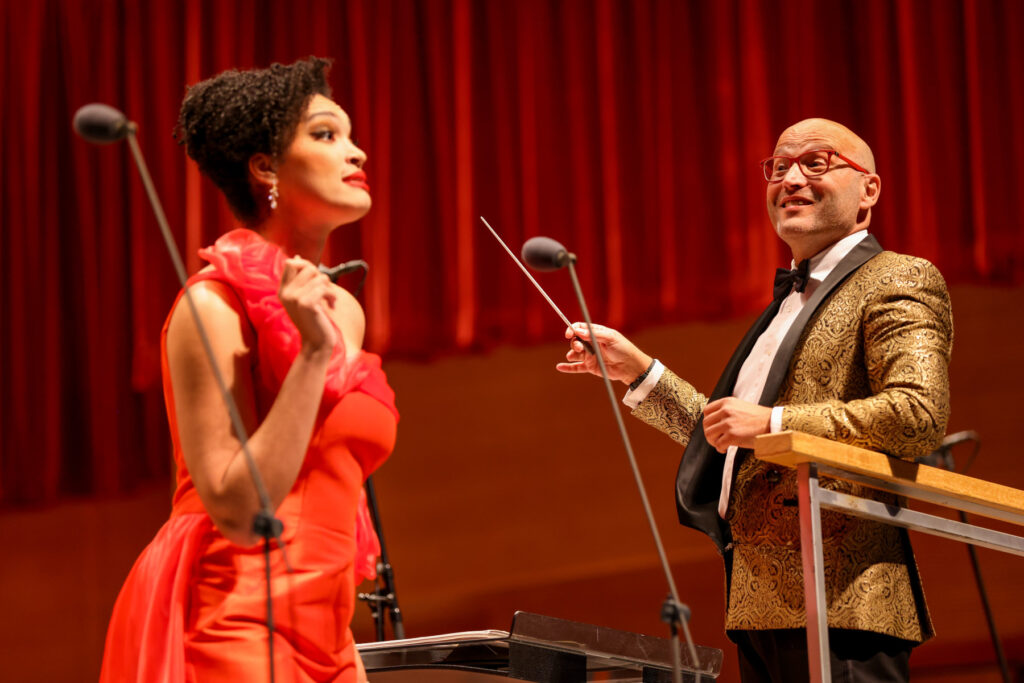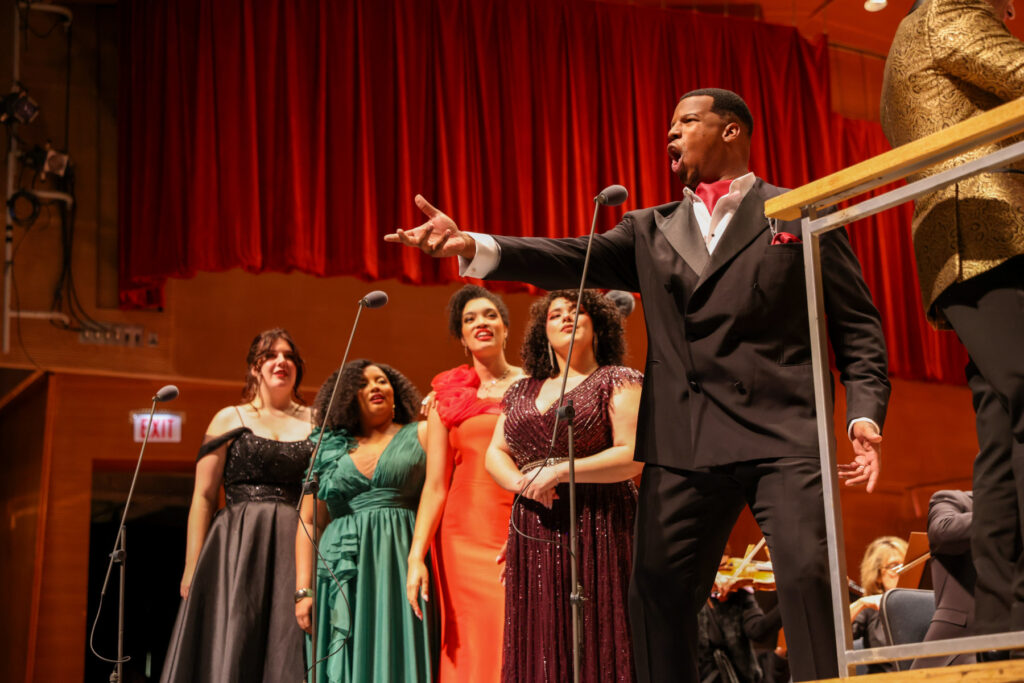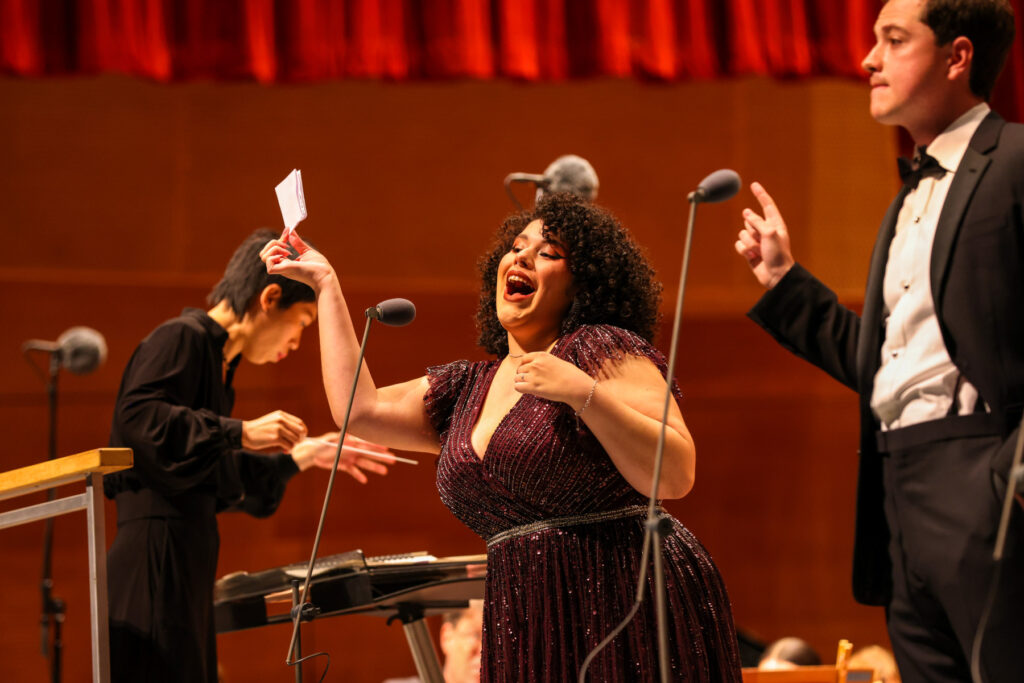On 7 September 2025, Lyric Opera of Chicago presented its annual concert in Millennium Park, during which a preview of the 2025/2026 season was combined with additional highlights from traditional and popular music. This year’s program also featured a brief excerpt from the Joffrey Ballet’s new production of Carmen, scheduled for performance later this month on the stage of the Civic Opera House. Performers of the operatic and popular numbers were current members of the Patrick G. and Shirley W. Ryan Opera Center. The Lyric Opera Orchestra was conducted by its music director Enrique Mazzola and by Chi-Yuan Lin. The collaborative pianist was Michael Banwarth, likewise a member of the Ryan Opera Center.
The ballet scene from Carmen suggests, through repeated intricate movements, the power of seduction and its ability to cause distraction. The male dancers dressed in uniform black paired off individually with the female dancer representing Carmen. Lithe choreography caused her brightly shaded costume to mesmerize the others until she awarded herself to one soldier. Despite the potential effectiveness of a cramped setting, one can assume that such a scene would play out with dramatic purpose when not positioned in front of a large accompaniment.

The operatic selections began with Mazzola leading a performance of the overture to Luigi Cherubini’s Medea, with which the season will open in October. The sense of tension to follow in the impending operatic narrative emerged in the swirling tempos under Mazzola’s direction. Individual motifs and instrumental groups received increasing clarity as the overture progressed toward its dramatic close.
Vocal excerpts began with the duet “A quest’ ora” between Nedda and Silvio from Ruggero Leoncavallo’s Pagliacci, here performed by Emily Richter and Sankara Harouna. Both singers showed an emotionally expressive command of their characters in this lengthy passage, while Mr. Harouna dominated through his use of dramatic force. Toward the close of this duet the figure of Tonio, performed by Christopher Humbert, Jr. observed in rapt attention while Richter’s pointed top notes reaffirmed her character’s resolve. In the sextet, “Alla bella Despinetta” from Act One of Wolfgang Amadeus Mozart’s Così fan tutte, the Don Alfonso of baritone Benjamin R. Sokol assumed his lead with commanding vocal tone until Despina was raised to his near equal. Alexis Peart sang the role of Despina with a range wider than the soubrette ordinarily cast in this role, yet this possibility was matched by dramatic commitment.

The two excerpts following for tenor and soprano from Giacomo Puccini’s Madama Butterfly were sung with noteworthy attention to style. Daniel Espinal’s performance of “Addio fiorito asil” caught the sense of regret at being compelled to leave a tradition which he has now shaded with dishonor. Espinal’s top notes bloom with a heartfelt, metallic sheen, while his graceful legato blends this talent with an equally lyrical approach. In the role of Cio-Cio San Adia Evans gave a full-voiced account of “Un bel di,” in which her pure high notes and use of color to express her character’s complexity made for an effective portrayal. Ms. Evans has a dramatic voice and is able to close a scene, as here, with memorable power.
After a performance of the Intermezzo from Pietro Mascagni’s Cavalleria rusricana two songs added variety to the program. Both were accompanied on piano with appropriate spirit by Mr. Banwarth. Hoagy Carmichael’s “Georgia on My Mind” was sung by Travon D. Walker while drawing on all imaginable elements from the realms of jazz and blues. Mr. Walker’s vocal range gave true distinction to the repeats, so that variation ideally enhanced the song’s progression. Mr. Sokol sang Harold Arlen’s “Lydia, the Tattooed Lady” to truly delightful effect. Sokol’s performance of the cleverly written text allowed the humor to emerge. Further, he retained the narrative line, which prompted the listeners to crave more descriptive details of the Lady Lydia. The performance with Sokol’s teasing legato was one of the evening’s highlights.

Yet another baritone showpiece followed in Sihao Hu’s rendition of “Largo al factotum” from Gioachino Rossini’s Il barbiere di Siviglia. Mr. Ju’s vocal approach has all the requisite skills called for in this challenging aria: his line is flexible, coloratura is impressively accurate, and his top notes are comfortably secure. Toward the close Hu’s rapid lines and sustained pitches brought Figaro’s entrance to an exciting climax. Also from Rossini’s opera Camille Robles and Finn Sagal performed the duet “Dunque io son.” Especially noteworthy in this excerpt was the degree to which the singers’ voices blended at various pitches, so that coloratura runs and dramatic moments were captured with noticeably proper timing.
The final two selections, from Georges Bizet’s Carmen, allowed for individual and collective performances. Ms. Peart sang “Pres des ramparts de Seville” seductively and with growing intensity, resulting in a strong portrayal of Carmen’s persona in Act One of the opera. The final excerpt, “Votre Toast,” showcased the evening’s ensemble led by Christopher Humbert, Jr.’s resounding Escamillo.
The program was a well-conceived and fitting tribute to the Ryan Opera Center and to the Lyric Opera of Chicago’s forthcoming season.
Salvatore Calomino
All photos by Kyle Flubacker